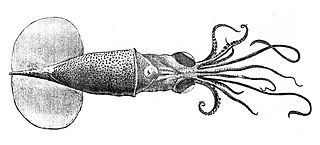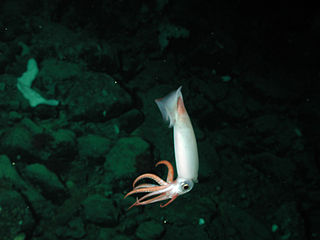
Joubiniteuthis portieri, also known as Joubin's squid from the monotypic family Joubiniteuthidae and genus Joubiniteuthis. It is a rare, small squid which occurs in the mesopelagic to bathypelagic zones and which has a worldwide distribution in tropical and subtropical regions. It is a distinctive squid having long arms I-III which have numerous small suckers in six rows. Its biology is little known. It is thought that it stays in the depths of the ocean with its arms outstretched, waiting for small animals to ensnare after they have accidentally swum into the arms. This species is named after Louis Joubin, a French zoologist. It is known to reach a mantle length of 9 cm (3.5 in).

The Mastigoteuthidae, also known as whip-lash squid, are a family of small deep-sea squid. Approximately 20 known species in six genera are represented, with members found in both the mesopelagic and bathypelagic zone of most oceans. Originally described by Verill in 1881, it was later lowered by Chun (1920) to a subfamily (Mastigoteuthinae) of the Chiroteuthidae. However, Roper et al. (1969) raised it back to the family level, and this has not been changed since. The taxonomy of this family is extremely unstable, and there have been at times one genus, two genera and four subgenera(Salcedo-Vargas & Okutani, 1994), two genera and several 'groups', five genera and one species with an uncertain placement, or six genera.

The Octopoteuthidae are a family of squid comprising two genera. The family is characterized by tentacles which cease to grow after the paralarval stage, and the use of a penis, instead of a hectocotylus.

Amphitretidae is a family of mesopelagic octopods which contains three subfamilies, formerly classified as families in their own right. It is classified in the superfamily Octopodoidea. Species in the family Amphipetridae are characterised by having a single row of suckers on each arm, a gelatinous body and non hemispherical eyes.

Leachia is a genus containing eight species of glass squids. The genus was formerly divided into two subgenera: Leachia and Pyrgopsis, but is no longer.

Cranchiinae is a subfamily containing four genera of glass squids.

Galiteuthis is a genus of glass squids from the family Cranchiidae and the subfamily Taoniinae. Squids in the genus Galiteuthis are large squids with mantle lengths measuring up to 660 mm (26 in), although it has been suggested that mantle length could reach as much as 2.7 m. The most distinctive feature of the speciesa in this genus are they have hooks on the tentacular clubs while there are no hooks on the arms, and by their long, thin, terminal fins.
Egea inermis is a species of glass squid in the monotypic genus Egea.

Taningia is a genus of squid in the family Octopoteuthidae. For over 150 years, it has been believed to comprise a single species known as Taningia danae. Recently it has been shown to contain at least two new species. Another species, Taningia persica, has historically been referred to but has been questioned.

Taningia danae, the Dana octopus squid, is a species of squid in the family Octopoteuthidae. It is one of the largest known squid species, reaching a mantle length of 1.7 m (5.6 ft) and total length of 2.3 m (7.5 ft). The largest known specimen, a mature female, weighed 161.4 kg (356 lb).
Echinoteuthis danae is a species of whip-lash squid. Known only from specimens of paralarvae, the species may be the juvenile form of Echinoteuthis atlantica.
Mastigoteuthis is a genus of whip-lash squid containing at least seven valid species. Some teuthologists consider Idioteuthis synonymous with this taxon.

Echinoteuthis atlantica is a species of whip-lash squid from the family Mastigoteuthidae. It occurs in the eastern North and South Atlantic Ocean. This squid is red in colour and similar to Echinoteuthis famelica of the Pacific but differs in having a well developed protective membrane on the tentacular club which is absent on E. famelica. The presence on this membrane on Echinoteuthis glaukopis from the Indian Ocean suggests that this may be a synonym of E. atlantica, in which case glaukopis has priority.

Pteroctopus is a genus of octopuses in the family Octopodidae.
Cycloteuthis is a genus of squid in the family Cycloteuthidae. It is distinguished from the genus Discoteuthis by the presence of a tail on the mantle. The species C. akimushkini is currently considered a junior synonym of C. sirventi, however this is inconclusive and the World Register of Marine Species has C. akimushkini as a valid species.

Abraliopsis is a genus of squid in the family Enoploteuthidae, comprising 11 nominal species. Species are characterised by the presence of photophores on arm pair IV. Suckers are absent from this arm. The type species is Abraliopsis hoylei.

Planctoteuthis danae, or Dana's Chiroteutid squid, is a species of chiroteuthid squid. It is distinguished from further members of Planctoteuthis by a fin length greater than half of the mantle. During the paralarval stage, the species occurs in depths of 200–300 m (660–980 ft), progressing to 200–800 m (660–2,620 ft) at 10–15 mm (0.39–0.59 in) ML; larger specimens have been captured from 700 m (2,300 ft) to in excess of 1,000 m (3,300 ft). The type locality of P. danae is in the Gulf of Panama, and it has also been recorded from the eastern Pacific Ocean and North Atlantic Ocean.

Gonatus is a genus of squid in the family Gonatidae, comprising twelve species, and therefore containing the most species in the family. Adult squid belonging to species in this genus are notable for their lack of tentacles.
Octopoteuthis danae is a little known species of small squid in the genus Octopoteuthis of the family Octopoteuthidae. They belong to the pelagic squid order Oegopsida. It is found in the Atlantic Ocean. It is distinguished from the other known similar Atlantic species, Octopoteuthis megaptera, by having a shorter tail which has two photophores. Its specific name honours James Dwight Dana (1813–1895) the American mineralogist and geologist who was a member of the U.S. Exploring Expedition in the Pacific of 1838–42 under Charles Wilkes. This expedition discovered that Antarctica was a continent and named it.

Octopoteuthis is a genus of squid. It is one of two genera in the family Octopoteuthidae, the other being Taningia. Both Octopoteuthis and Taningia are characterized by their lack of tentacles for the majority of their life cycle, and have traits characteristic of both squids and octopods. The species limits of the genus are in need of further research, for example some authorities have stated that the Mediterranean species Octopoteuthis sicula is apparently the senior synonym of Octopoteuthis danae and that it is very closely related to, or possibly conspecific with, Octopoteuthis megaptera.















